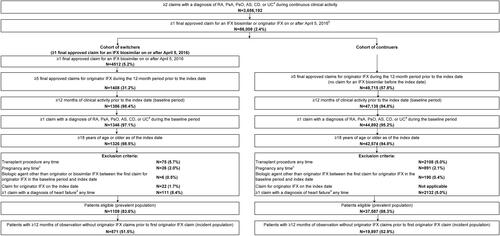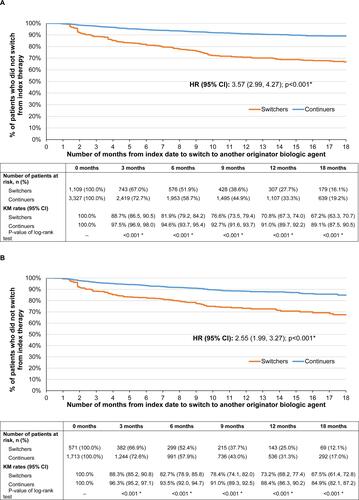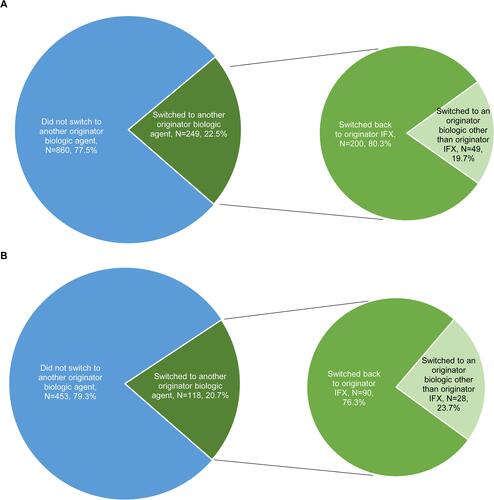Figures & data
Figure 1 Study design.

Figure 2 Patient selection.
Notes: aDiagnosis was identified using the following ICD-9 CM and ICD-10 CM codes: RA (ICD-9 CM code 714.0; ICD-10 CM code: M05.1-M05.9, M06), PsA (ICD-9 CM code 696.0; ICD-10 CM code: L40.5x), PsO (ICD-9 CM code 696.1; ICD-10 CM code: L40.0-L40.4, L40.8, L40.9), or AS (ICD-9 CM code 720.0; ICD-10 CM code: M45.x), CD (ICD-9 CM code 555.x; IDC-10 CM code K50.x), UC (ICD-9 CM code 556.x; IDC-10 CM code K51.x). bOriginator IFX was identified using the GPI code 5250504000 and HCPCS code J1745. IFX biosimilars were identified using the following codes: infliximab-abda (GPI code 5250504010; HCPCS code Q5102, Q5103), infliximab-dyyb (GPI code 5250504020; HCPCS code Q5102, Q5104), and infliximab-qbtx (GPI code 5250504060). cPregnancy was identified using the ICD-9 CM code V22.x and ICD-10 CM codes Z33.x and Z34.xx. dDiagnosis of heart failure was identified using the ICD-9-CM code 428.xx and ICD-10-CM code I50.x.
Abbreviations: AS, ankylosing spondylitis; CD, Crohn’s disease; GPI, Generic Product Identifier; HCPCS, Healthcare Common Procedure Coding System; ICD-9 CM/ICD-10 CM, international classification of disease, ninth/tenth revision, clinical modification; IFX, infliximab; PsA, psoriatic arthritis; PsO, plaque psoriasis; RA, rheumatoid arthritis; UC, ulcerative colitis.

Table 1 Baseline Demographic and Clinical Characteristics
Figure 3 KM curves of (A) time to switch to another originator biologic among the prevalent population and (B) time to switch to another originator biologic among the incident population.

Figure 4 Proportion of patients switching to another originator biologic agent among switchers in the (A) prevalent population (N=1109; mean observation period of 337 days) and (B) incident population (N=571; mean observation period of 314 days).

Table 2 KM Analysis of Time to Switch to Another Originator Biologic (Including Originator IFX) for the RA and IBD Subgroups
Figure 5 Switching and discontinuation rates for prevalent (switchers, N=1109; continuers, N=3327) and incident (switchers, N=571; continuers, N=1713) patients in the overall population, prevalent (switchers, N=464; continuers, N=1392) and incident (switchers, N=220; continuers, N=660) patients in the RA subgroup, as well as prevalent (switchers, N=523; continuers, N=1569) and incident (switchers, N=271; continuers, N=813) patients in the IBD subgroup.

